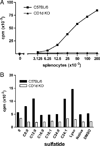Multiple tissue-specific isoforms of sulfatide activate CD1d-restricted type II NKT cells
- PMID: 19582739
- PMCID: PMC4212524
- DOI: 10.1002/eji.200839001
Multiple tissue-specific isoforms of sulfatide activate CD1d-restricted type II NKT cells
Abstract
The glycosphingolipid sulfatide (SO(3)-3Galbeta1Cer) is a demonstrated ligand for a subset of CD1d-restricted NKT cells, which could regulate experimental autoimmune encephalomyelitis, a murine model for multiple sclerosis, as well as tumor immunity and experimental hepatitis. Native sulfatide is a mixture of sulfatide isoforms, i.e. sulfatide molecules with different long-chain bases and fatty acid chain lengths and saturation. Here, we demonstrate that sulfatide-specific CD1d-restricted murine NKT hybridomas recognized several different sulfatide isoforms. These included the physiologically relevant isoforms C24:1 and C24:0, major constituents of the myelin sheet of the nervous system, and C16:0, prominent in the pancreatic islet beta-cells. The most potent sulfatide isoform was lysosulfatide (lacking a fatty acid). Shortened fatty acid chain length (C24:1 versus C18:1), or saturation of the long fatty acid (C24:0), resulted in reduced stimulatory capacity, and fatty acid hydroxylation abolished the response. Moreover, sulfatide was not responsible for the natural autoreactivity toward splenocytes by XV19 T hybridoma cells. Our results reveal a promiscuity in the recognition of sulfatide isoforms by a CD1d-restricted NKT-cell clone, and suggest that sulfatide, a major component of the myelin sheet and pancreatic beta-cells, is one of several natural ligands for type II CD1d-restricted NKT cells.
Conflict of interest statement
Conflict of interest: The authors declare no financial or commercial conflict of interest.
Figures






References
-
- Bendelac A, Savage PB, Teyton L. The biology of NKT cells. Annu. Rev. Immunol. 2007;25:297–336. - PubMed
-
- Barral DC, Brenner MB. CD1 antigen presentation: how it works. Nat. Rev. Immunol. 2007;7:929–941. - PubMed
-
- Shamshiev A, Donda A, Carena I, Mori L, Kappos L, De Libero G. Self glycolipids as T-cell autoantigens. Eur. J. Immunol. 1999;29:1667–1675. - PubMed
Publication types
MeSH terms
Substances
Grants and funding
LinkOut - more resources
Full Text Sources
Other Literature Sources
Molecular Biology Databases

